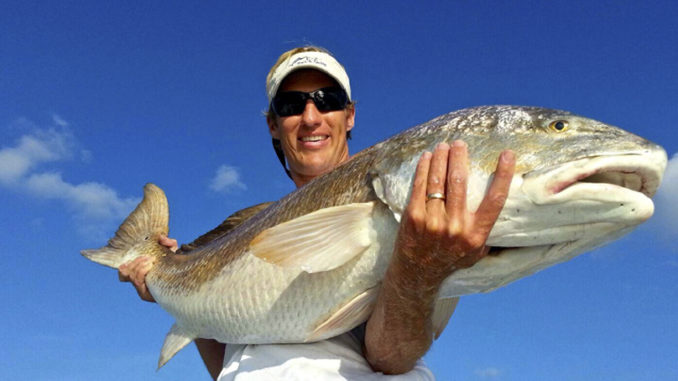
Find their food, find ambush spots, and put out the right bait and lures
Few fisheries get an angler’s blood pumping like spawning red drum in the Pamlico Sound and its tributaries. While many of these big fish are already being hoisted for glory shots, Capt. Mitchell Blake of Chocowinity’s Fish IBX Charters, said the best is yet to come. Find out what to look for and how to close the deal by following his tips.
Find the red drum food
Blake (252-495-1803) locates trophy red drum by putting his money where their mouth is. “Whether you’re fishing the Neuse River, Pamlico River, Pungo River or the Pamlico Sound, finding the major biomass within that body of water is the number one factor for putting fish in the boat,” he said.
“The biomass is all the living things that go with the fishery needed to sustain the drum. Shrimp, menhaden, mullet, and crabs will be the key food sources. Old drum are big, mature fish, and they have a big appetite,” he said.
Blake said that riding and surveying the water looking for large schools of baitfish is the best way to find them.
Find ambush spots
Although reds are subject to be anywhere the bait is, targeting the areas where they are most likely to attack will narrow the playing field. “When I start seeing bait pods, I’ll reference my maps or past experience to dissect the area and find the sweet spots,” Blake said. “I focus on ambush areas, like a point that has good flow around it or a ledge, any kind of depth change that will bottleneck the baitfish. Look for a drop off of a least a couple feet, versus a gradually sloping area, like a shoal with a slough running through it.”
Blake also pays close attention to structure like shell beds.
When to use cut bait for red drum
With all the hype surrounding artificials, using cut bait may seem a bit old fashioned, but there are still times when it is the most effective.
“I like bait-fishing for hungry fish and casting artificials for aggressive fish,” said Blake, suggesting that he is more apt to utilize the scent factor of cut bait in the early morning and evening when drum are most naturally looking for a meal.
Blake also fishes cut bait early in the season when fewer fish are in the system, in murky water, or when the wind makes casting artificial baits an obstacle.
His version of the mandatory Owen Lupton rig consists of a 9/0 circle hook (with compressed barb), a 60-pound fluorocarbon leader (6 inches or less), and a fixed 3- to 4-ounce egg weight at the swivel. Bait of choice would be menhaden, second comes mullet or even blue crab.
When to use artificial baits
“I use artificials around aggressive, schooling fish,” said Blake, who believes these baits draw more reaction strikes throughout the day. “I put a lot of emphasis on seeing activity and responding to it. Whether it’s drum pushing water or bait, splashing, or finning, artificial baits trigger their aggressive nature.”
Blake prefers a popular popping cork rig for fish he sees near the surface, with a Bomber cork, 2-foot leader, and a Yee-Ha swimbait. During more windy conditions or when drum aren’t visible on top, he favors a Bomber Super Pogey lipless crankbait.



